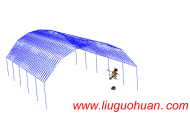求解结构地震响应位移输入模型中存在问题的一种新解决方法作者: 柳国环,李宏男,国巍,田利 |
||||||
下载次数:
次 更多论文下载...
PDF格式(左键浏览,右键另存):
2010 年 9 月
摘要:为了更现实有效地解决求解结构地震反应的当前位移输入模型中容易但不容忽视的问题,进一步提出了一种新的解决方法——附加无质量刚性元法,旨在能够推广并应用于工程实际。首先,回顾当前求解结构地震反应的位移输入模型,描述了模型中存在的问题;然后,提出了无质量刚性元法,并对该方法进行物理角度解释、理论分析和数值验证,进一步应用于一桥梁工程。分析表明:无质量刚性元法不仅物理概念清晰、合理易行,而且与以往文献中的附加无质量束缚元(Appended Massless Constraint Element,AMCE)法相比,避免了“束缚”条件,无需对现有的有限元程序内核改进或者嵌入新的外挂程序即可实现,因此更具有现实性和推广意义。 关键词:地震;位移输入模型;桥梁;附加无质量刚性元法;附加无质量束缚元法 中图分类号:P315.9; U442 文献标识码:A 文章编号:1000-4750(2010)09-0055-08 Abstract:A new method is presented and proposed to settle the problem, easy but not to be neglected, existing in the current displacement input model for the seismic-responses analysis of multi-degree-of-freedom multi-supported structures subjected to spatially ground motion. The method is called appended massless rigid element method. Firstly, the current displacement input model is reviewed, and the unnegligible problem inherent in it is described in detail. To solve the problem, the spring impedance method is presented. Then, the rationality and accuracy of the proposed method are further verified. Moreover, the method is applied to bridge engineering.Theoretical analysis and numerical results demonstrate that the proposed method is not only has the characteristics of explicit physical meaning, simplicity and feasibility, but also compared with the AMCE method in the previous literature. It avoids constraint condition and does not require additional improvement or subprogram for existing general finite element program. So, appended massless rigid element method is more realistic and is worthy to be generalized. Key words:earthquake; displacement input model; bridge; appended massless rigid element method; appended massless constraint element method 引言 地震地面运动作用下,结构动力反应的数值分析常采用两种计算模型:一致加速度输入模型和位移输入模型。一致加速度输入模型已被充分认可并广为应用,它适用于地震动一致激励下结构的线性和非线性反应分析,计算得到的结构反应是相对量值(相对于地面)。事实上,实际地震动具有不一致性[1―4](例如:行波、相干和局部场地效应),这一性质对结构尤其是对大跨桥梁、输电塔-线体系、网壳、网架、以及地下管线等结构的动力反应影响更为明显[1, 4―10]。目前,地震动多点输入(即差动输入)问题已成为抗震界研究热点之一,这时位移输入模型则常被采用[10―13]。该模型不仅适用于一致激励还适用于多点激励,既适用于结构线性也适用于其非线性分析,直接得到的计算结果是绝对量值,当前被认为是一种求解结构地震反应的具有普适性和有效性的计算模型[13]。 位移输入模型的重要性在于它的基础性和应用广泛性。近年来,学者们对该模型的计算精度、时域分析方法对其适用性和模型本身存在的问题以及解决方法方面又进行了相关研究:文献[11]指出,采用该模型和直接积分法计算结构反应时,预得到较好精度的解需非常小的积分步长,并认为模态叠加法可适用于位移输入模型;文献[13]通过理论分析论证了采用相同的积分步长时,位移输入模型可获得比一致加速度模型得到更高的计算精度,并通过一算例对此进行了验证。应该指出,此算例没有考虑阻尼的影响;文献[14]指出,由于结构绝对反应中包含地面运动部分而不可振型分解,因此模态叠加法和反应谱法均不适用于位移输入模型,进而指出不将结构绝对反应分解为拟静力与动力反应而试图通过对绝对反应直接振型分解并进一步推导出多点反应谱的方法在理论上不可行;文献[15]明确指出了当前位移输入模型“理论似乎完善,仔细分析,其实不然”,并对其不容忽视的问题进行了详细分析,进而提出了AMCE 实效解决方法并对一简单算例编制程序加以验证。然而AMCE法虽可通过编制程序实现,但对于实际复杂工程而言则显得力不从心。鉴此,寻求一种更好地解决方法,并能够将其在当前通用大型有限元程序中实现则更加具有现实性和推广意义,这也是本文的出发点。 本文首先回顾了当前求解结构地震响应的位移输入模型,然后详细描述了模型中存在的问题,进一步提出了无质量刚性元法,并对该方法进行了物理角度解释、理论分析和数值验证;最后,将该方法应用于实际一桥梁工程,以进一步说明方法的现实性。与作者已经提出的AMCE 对策相比,无质量刚性元法有如下3 个优点:1) 将位移输入模型理论存在的问题通过数值模型建立加以解决的方法更加巧妙;2) 避免了AMCE 方法中的附加“束缚”条件;3) 对于已采用当前位移输入模型的大型有限元软件,无需其内核程序的改进或者被嵌入新的外挂程序即可对实际工程结构进行分析。简言之,无质量刚性元法,合理、实用,便于推广,此乃为上策。 结论 本文针对当前求解结构地震响应的位移输入模型存在的问题,为了更方便于利用通用有限元程序即可解决实际工程问题,在基于已有工作基础之上,进一步作了如下两项工作: (1) 提出了无质量刚性元法,其优点可避免以往文献中AMCE 解决方法对支座与支座附近节点强制“束缚”要求,该方法物理意义清晰、合理可行。 (2) 将无质量刚性元法在大型有限元程序SAP2000 加以实现,并应用于一桥梁工程,进而说明本文方法实用性,可以推广应用。 参考文献(References): [1] 李宏男. 结构多维抗震理论[M]. 北京: 科学出版社,2006.Li Hongnan. Earthquake resistant theory of structures to multi-dimensional excitations [M]. Beijing: Science Press, 2006. (in Chinese) [2] 丁阳, 林伟, 李忠献. 大跨度空间结构多维多点非平稳随机地震反应分析[J]. 工程力学, 2007, 24(3): 97―103.Ding Yang, Lin Wei, Li Zhongxian. Analysis models and methods for structural seismic responses [J]. Engineering Mechanics, 2007, 24(3): 97―103. (in Chinese) [3] 李忠献, 史志利. 行波激励下大跨度连续钢构桥的地震反应分析[J]. 地震工程与工程振动, 2003, 23(2),68―76.Li Zhongxian, Shi Zhili. Seismic response analysis for long-span continuous rigid-framed bridges under excitation of traveling waves [J]. Earthquake Engineering and Engineering Vibration, 2003, 23(2), 68―76. (in Chinese) [4] 屈铁军, 王前信. 多点输入地震反应分析的进展[J].世界地震工程, 1993, 9(1): 30―36.Qu Tiejun, Wang Qianxin. A progress in research on seismic response analysis under multi-supports excitation [J]. World Information on Earthquake Engineering, 1993,9(3): 30―36. (in Chinese) [5] 潘旦光, 楼梦麟, 范立础. 多点输入下大跨结构地震反应分析现状[J]. 同济大学学报, 2001, 29(10): 1213―1219.Pan Danguang, Lou Menglin, Fan Lichu. Status of seismic response analysis of long-span Structures under multiple support excitations [J]. Journal of Tongji Universit, 2001, 29(10): 1213―1219. (in Chinese) [6] 薛素铎, 王雪生, 曹资. 空间网格结构多维多点随机地震响应分析的高效算法[J]. 世界地震工程, 2004,20(3): 43―49.Xue Suduo, Wang Xuesheng, Cao Zi. An efficient algorithm for multi-dimensional and multi-support random seismic analysis of spatial reticulated structures [J]. World Earthquake Engineering, 2004, 20(3): 43―49.(in Chinese) [7] 全伟, 李宏男. 大跨结构多维多点输入抗震研究进展[J]. 防灾减灾工程学报, 2006, 26(3): 343―349.Quan Wei, Li Hongnan. State-of-the-Art review on multi-component multi-support Seismic response analysis of long-span structures [J]. Journal of Disaster Prevention and Mitigation Engineering, 2006, 26(3): 343―349. (in Chinese) [8] 叶继红, 孙建梅. 多点激励反映谱法的理论研究[J].应用力学, 2007, 24(1): 49―53.Ye Jihong, Sun Jianmei. Response spectrum method for multi-Support seismic excitations [J]. Applied Mechanics,2007, 24(1): 49―53. (in Chinese) [9] 杨庆山, 刘文华, 田玉基. 国家体育场在多点激励作用下的地震反应分析[J]. 土木工程学报, 2008, 41(2):35―41.Yang Qingshan, Liu Wenhua, Tian Yuji. Response analysis of national stadium under specially variable earthquake ground motions [J]. China Civil Engineering Journal, 2008, 41(2): 35―41. (in Chinese) [10] Chopra Anil K. Dynamics of structures: Theory and applications to earthquake engineering [M]. 2nd ed. New Jersey: Prentice-Hall, Inc., 2001. [11] Wilson E L. Static and dynamic analysis of structures: A physical approach with emphasis on earthquake engineering [M]. Berkley, California: Computer and Structures, Inc, 2004. [12] Chopra Anil K. 结构动力学理论及其在地震工程中的应用[M]. 第2 版. 谢礼立, 吕大刚, 译. 北京: 科学出版社, 2006.Chopra Anil K. Dynamics of structures theory and applications to earthquake engineering [M]. 2nd ed.Translated by Xie Lili, Lu Dagang. Beijing: Higher Education Press, 2006. (in Chinese) [13] 田玉基, 杨庆山. 地震地面运动作用下结构反应的分析模型[J]. 工程力学, 2005, 22(6): 170―174.Tian Yuji, Yang Qingshan. Analysis models and methods for structural seismic responses [J]. Engineering Mechanics, 2005, 22(6): 170―174. (in Chinese) [14] 柳国环, 李宏男, 林海. 结构地震响应计算模型的比较与分析[J]. 工程力学, 2009, 26(2): 10―15.Liu Guohuan, Li Hongnan, Lin Hai. Model comparison and analysis for structural seismic responses [J].Engineering Mechanics, 2009, 26(2): 10 ― 15. (in Chinese) [15] 柳国环, 李宏男, 国巍. 求解结构地震响应位移输入模型存在的问题及其AMCE 实效对策[J]. 计算力学学报, 2009, 26(6): 862―869.Liu Guohuan, Li Hongnan, Guo Wei. Existing problem of displacement input model for calculating structural responses under earthquake ground motion and its an actual effective solution method called AMCE [J].Chinese Journal of Computational Mechanics, 2009,26(6): 862―869. (in Chinese) [16] Akkar S, Ozen O. Effect of peak ground velocity on deformation demands for SDOF systems [J]. Earthquake Engineering and Structural Dynamics, 2005, 34: 1551―1571. |
||||||
| welcome to www.liuguohuan.net |
| 天津大学 建筑工程学院 ; 天津大学 前沿技术研究院; 国家重点实验室-水利工程仿真与安全 |







